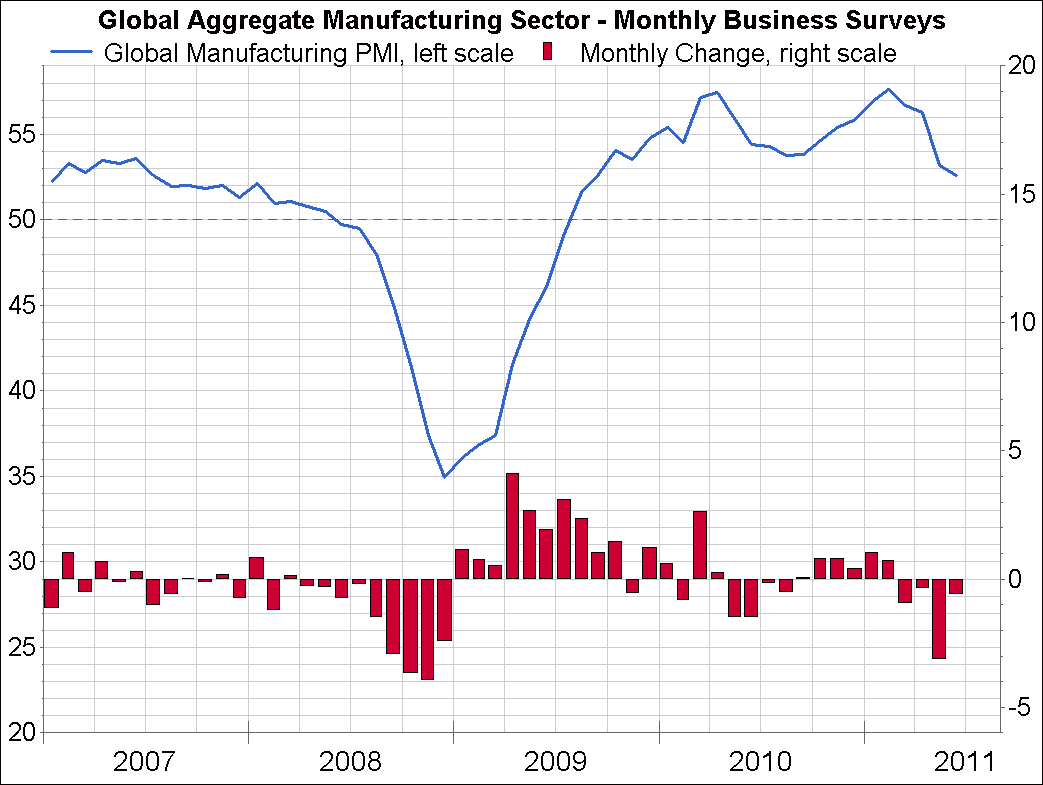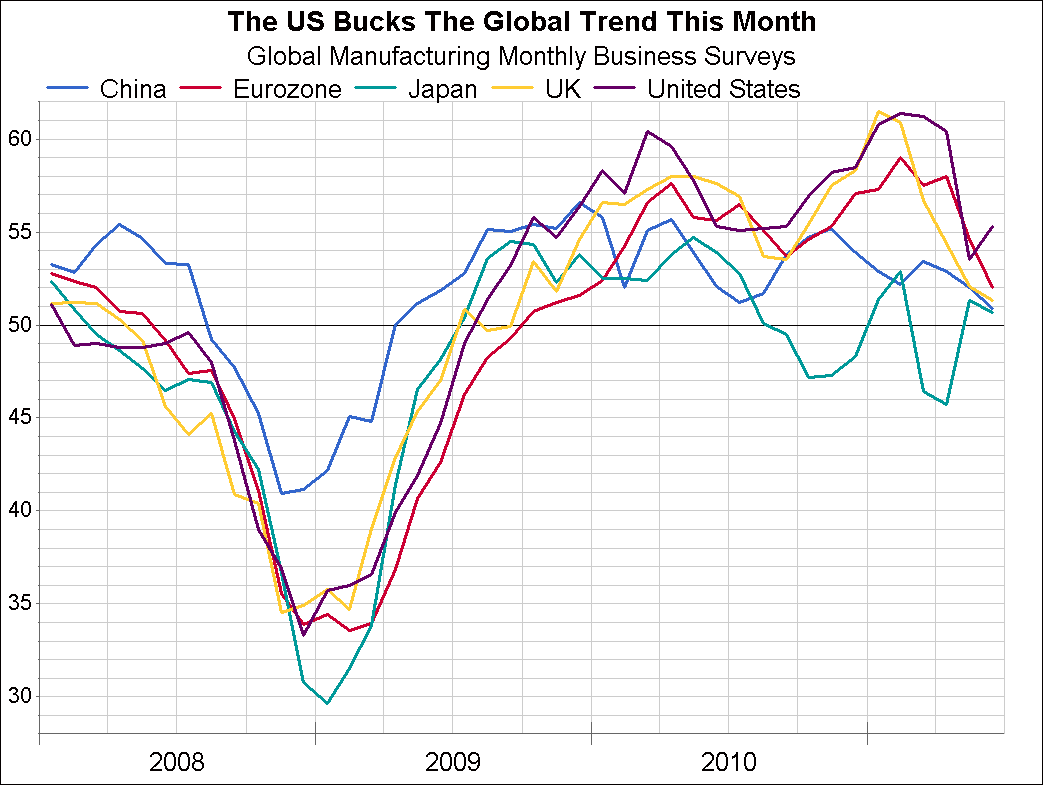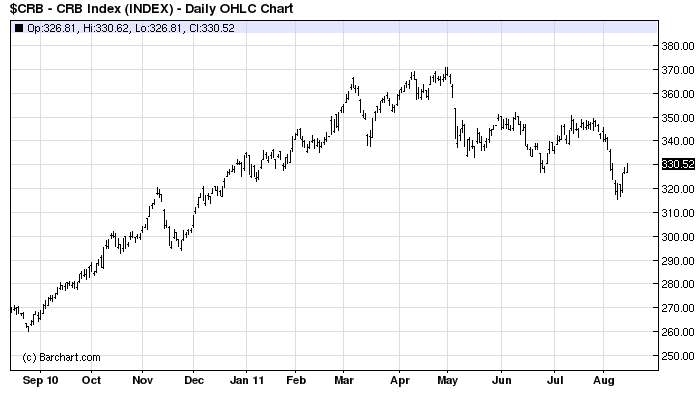Last night’s market action screams QE3. Anything physical – grains, oil, gold – went bonkers, whilst the $US and Treasuries got thrashed. Welcome to QE3 and a new “undollar” rally.
An “undollar” rally is, of course, the process of buying anything physical that is priced in US dollars and therefore is set to rise in price as the dollar falls on monetary easing.
The last round of this trade, QE2, was a complete no-brainer, taking the S&P from a low around 1040 to a high of 1360 some 8 months later. Will it last again this time?
There are some parallels that offer hope. For instance, in September 2010, the US PMI also dipped and the eurozone was basking in the glow of a new Greek bailout.
Also, here is an important piece from Credit Writedowns:
The third round of unconventional stimulus is now starting
Since then, the economy has weakened considerably. The Fed even said so directly – “economic growth so far this year has been considerably slower than the Committee had expected”. So now the QE3 speculation has begun.
Here’s what I think is happening at the Fed. Fed doves have wanted some sort of easing. Under consideration are targeting long-maturity asset purchases, setting an interest rate target or even eventually buying municipal bonds (see What QE3 could look like from June).
Fed hawks want no part of this. Look at the three dissents at the last meeting and Kocherlakota’s statement on dissenting the Fed’s permanent zero policy. So the doves have been forced to alter QE3. Here’s how I put it last month:
The Fed is likely to soft peddle this policy change because of comments from people like former Atlanta Fed President William Ford questioning Can the Fed Go Bankrupt? The Fed will want to stay to the shorter end so as not to risk its balance sheet by moving out the curve with interest rate caps. However, there could be internal dissent, so the Fed could start off by signalling to the market that it will conduct what I have been calling ‘permanent zero’. Eventually people will be forced to accept this – and the term structure will flatten further and further out the curve. That’s how Japan got to a 1% 10-year yield because expectations of zero rate policy continued to lengthen in time.
–Gross and Rosenberg: QE3 will see interest rate caps
This is what we just got last week, permanent zero. I believe this is the first salvo in a renewed easing campaign by the Fed. I had been saying full-blown QE3 wouldn’t begin until 2012. In fact, the permanence of the zero to which the Fed has committed is much longer than I had anticipated. I would go so far as to call this full-blown rate easing, one of the three easing policies I identified earlier as QE3 contenders. That’s why you got three dissents at the last FOMC meeting, which you will almost never see at the Fed.
The 0.375% US Treasury note maturing on 31 July 2013 is now yielding only 19 basis points. Call this financial repression, call it rate easing, call it permanent zero or whatever you want; What the Fed has just done is effectively guarantee interest rates out to two years. In essence, QE3 has already started – and that’s bullish for fixed income investors because it guarantees a floor for non-credit-related fixed income investment risk. Interest-rate risk is gone for investments up to two years; Private equity and leveraged finance will need to get busy.
Watch the upcoming speeches at Jackson Hole to see how much further the Fed is willing to go.
I’ve been of the view that zero short rates were basically permanent and I have never taken Fed tightening seriously anyway so this is a surprise to me. But, if CW is right, then this is a big deal, as the permanence of zero rates frees capital to pursue its various carry trades worry free for the medium term.
However, there’s also no doubt that the task confronting a Fed reflation this second time around is much greater. The broader global economy is weaker now than it was when QE2 was announced. From Gavyn Davies, look at this chart of aggregated global PMIs:

Moreover, the weakness is broad based:

Downward momentum is much greater in the global industrial economy now than it was in September 2010.
Moreover, in September 2010, global government stimulus was still supportive to growth, as opposed to the 1.5% of GDP now scheduled to be removed from the US economy over the next 12 months. In the Eurozone, the May ’10 Greek bailout was still accepted as effective and 10 year Irish bond yields were sitting around 5%. Now, we have banana republic yields across the periphery and new austerity packages in Greece, Ireland, Portugal and Italy.
China too was still growing strongly and its inflation rate was below 4%, enabling ongoing loose monetary conditions. Today growth is still strong but is slipping slowly as the PBOC tightens and inflation is at 6.5%. A strong QE3 may force further tightening as the slowdown advances.
Likewise, the US inflation rate was about 1%, as opposed to its current 4% or so.
The primary cause of this rise in inflation was the re-pricing of commodities emanating from QE2. In 2010, the CRB sat some 22% below its current level:

These look to me like very strong headwinds for those looking for an enduring and runaway QE3 rally. If you’re gonna play it, I recommend a short stop.

